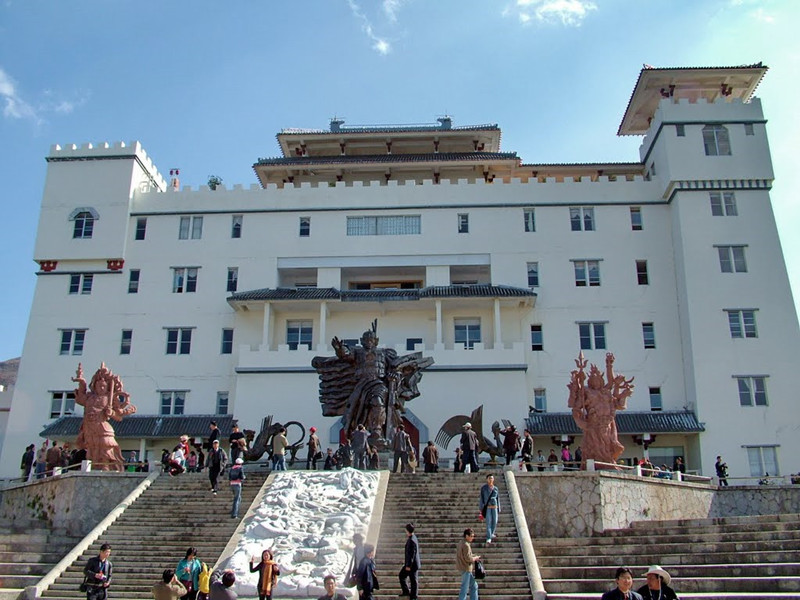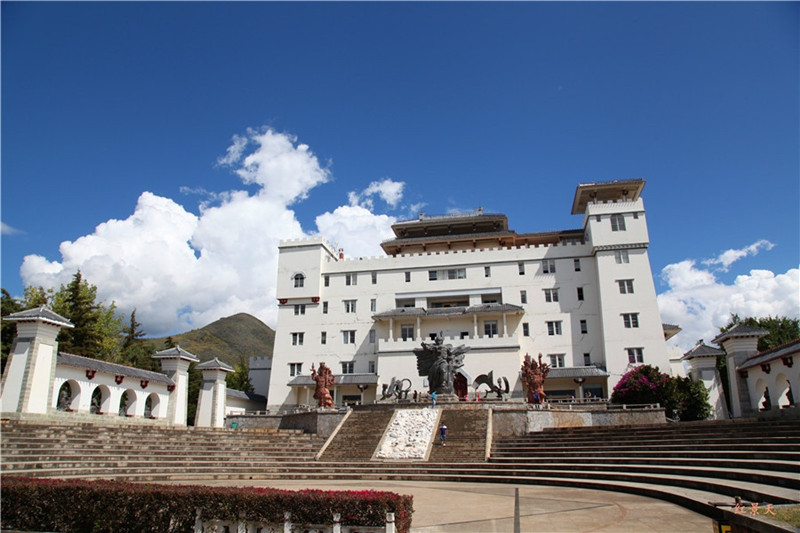Nanzhao Palace of Erhai Lake in Dali City
Overview of Nanzhao Palace
Nanzhao Palace (南诏行宫) is the main building on Nanzhao Romantic Island (南诏风情岛), serving as a summer retreat for the Nanzhao King (南诏王). The Nanzhao Kingdom (南诏) existed from 653 to 902 AD and had three capital cities, one of which was Taihe City (太和城) in Dali.
Scale
Nanzhao Palace is a remarkable architectural feat, reflecting the grandeur of ancient royal residences. The Nanzhao kings constructed a series of royal facilities around Erhai Lake (洱海), including summer palaces, imperial gardens, and hunting grounds. Historical records indicate that the southern and northern city walls of the Nanzhao capital measured 3,350 meters and 3,275 meters respectively, with a distance of 500 meters between them. This scale rivals that of the Forbidden City (故宫) in Beijing, although today, only remnants of the original structures remain.
Characteristics
The Nanzhao Palace is designed to resemble an ancient imperial palace. Influenced by Tibetan (吐蕃) and Tang (唐) cultures, its architecture features:
- Tang-style Roofs: Elegant and distinctively shaped.
- Tibetan Walls and Windows: Incorporating cultural elements from the Tibetan region.
- Dali Architectural Elements: Utilizing local construction styles and colors.
Covering over 8,000 square meters, the palace’s grandeur reflects the artistic achievements of the Nanzhao era. The local Bai (白族) culture also plays a significant role, particularly the worship of “Ben Zhu” (本主), a local deity revered as the protector of the community.
Cultural Significance
Historically, Nanzhao was a formidable military kingdom that began as a small tribe. With its military strength, it absorbed neighboring tribes (known as “Zhao”) around Erhai Lake, expanding its territory to areas now known as Sichuan, Guizhou, Guangxi, and even reaching Vietnam. At its height, Nanzhao encompassed 1.0736 million square kilometers—27 times the size of modern Yunnan Province (云南省). Nanzhao existed alongside the Tang Dynasty and Tibetan Empire for nearly two centuries.
The Nanzhao Palace showcases a blend of architectural styles influenced by Tang, Tibetan, and Dali cultures, featuring:
- Tang Roofs: Elegant and stylized.
- Tibetan Walls: Reflecting the influence of Tibetan design.
- Local Dali Features: Incorporating the distinctive elements of Dali’s architecture.
The Bai culture is prominent here, with the worship of “Ben Zhu” as a central belief. Each Bai community has its own shrine to the Ben Zhu, and festivals are held to celebrate this deity, enriching the cultural landscape of the area.
Visitor Information
Time Required
Visitors typically spend 1-3 hours exploring the palace and its surroundings.
Transportation
- Self-Driving Directions:
- Start from Dali Railway Station (大理市火车站).
- Take the Xijing Line (西景线) to Huanhai East Road (环海东路) until you reach the destination.
Opening Hours
- Hours: 08:30 – 17:00 (January 1 – December 31, Monday – Sunday)
Location
Nanzhao Palace is situated on Nanzhao Romantic Island (南诏风情岛), in Shuanglang Town (双廊镇), Dali Bai Autonomous Prefecture, Yunnan Province (云南省大理白族自治州大理市双廊镇南诏风情岛内).
Travel Tips
- Best Time to Visit: Spring (March to May) and autumn (September to November) are ideal for pleasant weather and beautiful scenery.
- Clothing Recommendations: Wear comfortable footwear for walking and climbing, as well as layers for changing temperatures near the lake.
- Respect Local Customs: Be respectful in religious areas and participate in local customs if invited, particularly during festivals.
- Explore Nearby Attractions: Consider visiting other sites in the area, such as Erhai Lake and local Bai villages, to enhance your cultural experience.
- Photography: Capture the beauty of the palace and the surrounding landscapes, while being mindful of the privacy of local communities and religious practices.
- Local Cuisine: Don’t miss trying local Bai dishes at nearby eateries, which showcase the rich culinary traditions of the region.
Visiting Nanzhao Palace offers a glimpse into the rich historical and cultural tapestry of the Nanzhao Kingdom, as well as the stunning natural beauty of Erhai Lake.


















